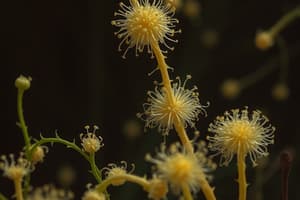Podcast
Questions and Answers
Which of the following is NOT considered a major group of microorganisms according to the text?
Which of the following is NOT considered a major group of microorganisms according to the text?
- Mycology (Fungi)
- Zoology (Animals) (correct)
- Virology (Viruses)
- Phycology (Algae)
What is the definition of microbiology?
What is the definition of microbiology?
- The study of macroscopic organisms
- The study of organisms visible to the naked eye
- The study of extinct organisms
- The study of microorganisms (correct)
In which habitat do microorganisms NOT multiply according to the text?
In which habitat do microorganisms NOT multiply according to the text?
- Soil
- Humans and animals
- Plants
- Atmosphere (correct)
Why was microbiology the last of the three major divisions in biology to develop?
Why was microbiology the last of the three major divisions in biology to develop?
What is the size range of microorganisms as mentioned in the text?
What is the size range of microorganisms as mentioned in the text?
What distinguishes microbiology from botany and zoology?
What distinguishes microbiology from botany and zoology?
Microbiology was recognized as a true science before the later part of the 19th century.
Microbiology was recognized as a true science before the later part of the 19th century.
Microorganisms can generally be perceived by the unaided human eye.
Microorganisms can generally be perceived by the unaided human eye.
Most microorganisms have a diameter greater than 1 mm.
Most microorganisms have a diameter greater than 1 mm.
Viruses fall into the domain of mycology.
Viruses fall into the domain of mycology.
All microorganisms can multiply in the atmosphere.
All microorganisms can multiply in the atmosphere.
Microorganisms collectively have a smaller population compared to other living cells on Earth.
Microorganisms collectively have a smaller population compared to other living cells on Earth.
Flashcards are hidden until you start studying




